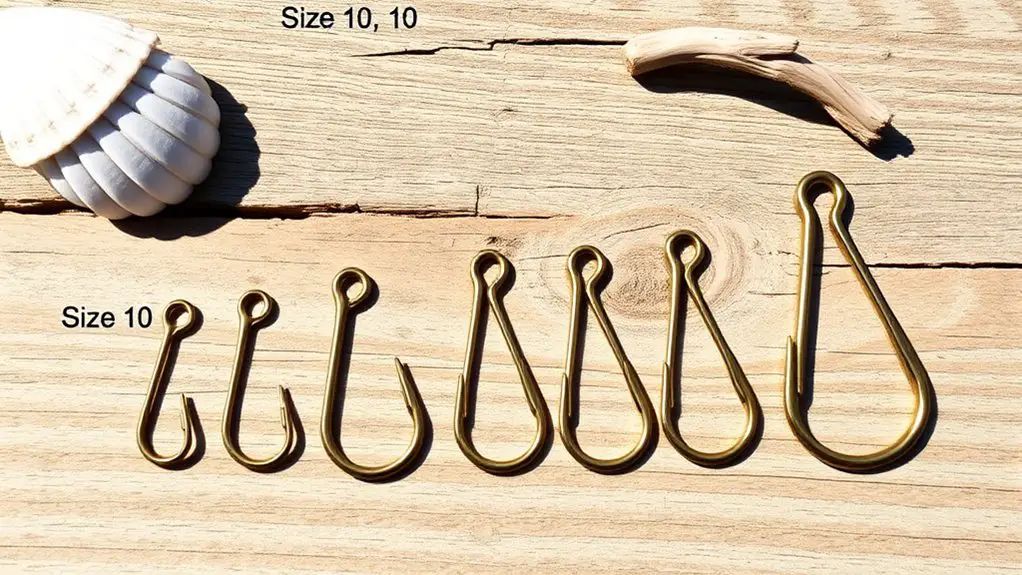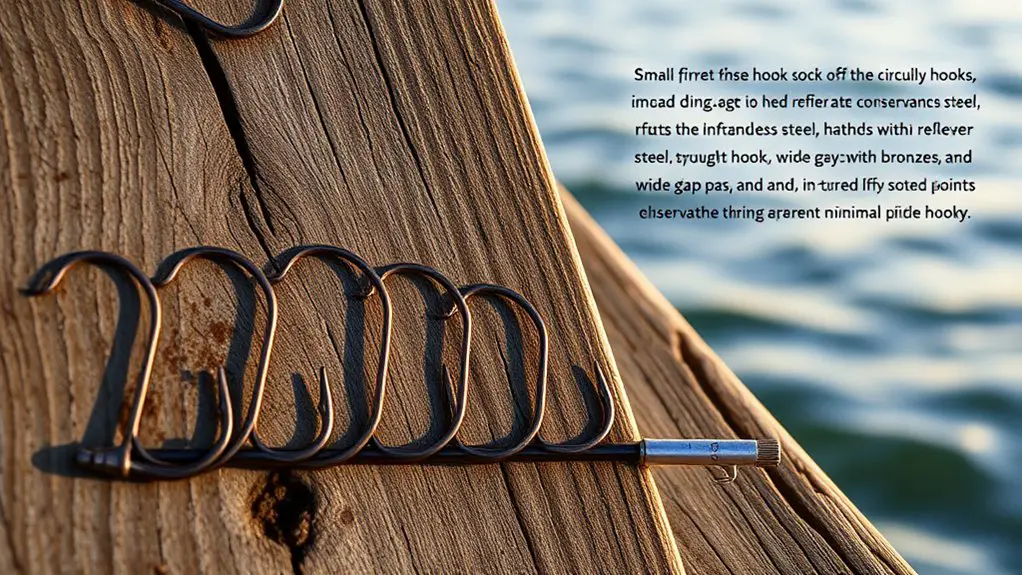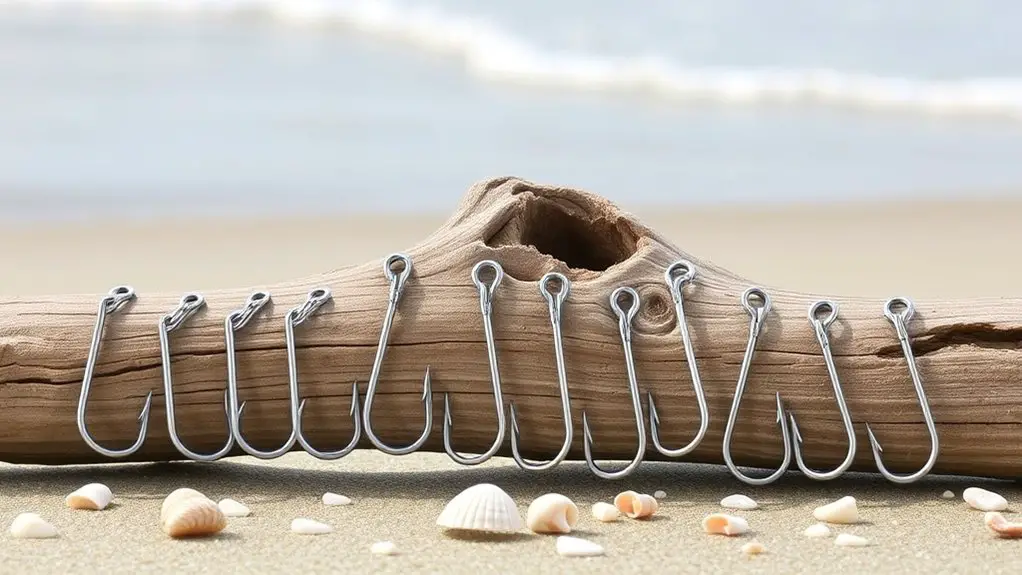For surf fishing success, hook size matters tremendously. Remember two systems: regular (#32 to #1, smaller as numbers increase) and aught (1/0 to 27/0, larger as numbers increase). Match hooks to your target—small #6-#2 for surf perch, #2-1/0 for pompano, 1/0-3/0 for redfish, and 4/0-8/0 for sharks. Your bait influences choice too; live bait needs smaller hooks while cut bait handles larger sizes. The right hook not only improves catch rates but also supports healthier fish populations when you’re ready to release.
Surf Fishing Highlights
- Hook sizes range from #32 (smallest) to 27/0 (largest), with regular hooks (#32-#1) decreasing in size as numbers increase.
- Match hook size to target species: #6-#2 for surf perch, #2-1/0 for pompano, 1/0-3/0 for redfish, and 4/0-8/0 for sharks.
- Select hook size based on bait type: larger hooks (2/0-5/0) for cut bait and smaller hooks (1/0-2/0) for live bait.
- Choose appropriate hook styles for different scenarios: J-hooks for active fishing, circle hooks for passive setups and catch-and-release.
- Use barbless or crimped-barb hooks made of non-stainless steel to minimize injury and practice sustainable fishing.
Understanding Hook Size Numbering Systems for Surf Fishing
Why do hook sizes seem designed to confuse even experienced anglers? It’s like they created the system just to test your sanity!
Fishing hook sizes: where logic goes to drown and sanity comes up empty on every cast.
Hook sizes follow two opposing systems: regular (numbered) and aught (with slashes). Regular hooks run from #32 (tiniest) to #1 (largest regular), getting smaller as numbers increase.
Aught hooks start at 1/0 and climb to 27/0, growing larger with each number. The largest aught hooks are specifically designed for large predators![]() like tuna and sharks, with prices ranging from $20 to $210 each.
like tuna and sharks, with prices ranging from $20 to $210 each.
Here’s the kicker—there’s no size zero! You jump straight from #1 to 1/0. These sizing systems are based on an old British measurement![]() that has evolved over time.
that has evolved over time.
For general surf fishing purposes, most anglers find that hooks ranging from #1 to #1/0![]() work well for catching a variety of gamefish species.
work well for catching a variety of gamefish species.
Best Hook Sizes for Common Surf Species
Selecting the right hook size makes the difference between a cooler full of fish and a frustrating day watching your bait disappear.
For smaller targets like surf perch and croaker, stick with #6 to #2 hooks that won’t spook these wary biters.
Step up to #2-1/0 when pompano or whiting are on your radar. The trusty 2/0 circle is your surf fishing Swiss Army knife, but when redfish or snook crash the party, reach for 1/0-3/0 models. Remember that specific hooks![]() may be required for certain species based on their mouth structure and feeding habits.
may be required for certain species based on their mouth structure and feeding habits.
Targeting toothy customers? Sharks and large rays demand 4/0-8/0 hooks, while jetty-hugging snapper respond best to 1/0-4/0 options. For better catch and release success, consider using circle hooks![]() which significantly reduce gut hooking compared to traditional J-hooks. Maintaining your hooks with a quick fresh water rinse
which significantly reduce gut hooking compared to traditional J-hooks. Maintaining your hooks with a quick fresh water rinse![]() after each saltwater session will prevent corrosion and extend their usability.
after each saltwater session will prevent corrosion and extend their usability.
Matching Your Hook Size to Your Target Catch
Beyond knowing which hooks work for popular surf species, successful anglers understand the art of precise matching.
You’ll want to align your hook with both fish size and bait selection—small #6 to #1 hooks for whiting and perch, #1/0 to 2/0 for redfish and bass, and 3/0 to 5/0 for larger specimens like snook and flounder.
Remember that thin wire hooks![]() are ideal when using live bait to maintain its natural movement and longevity in the water.
are ideal when using live bait to maintain its natural movement and longevity in the water.
Can’t decide? A 2/0 circle hook is your Swiss Army knife for multi-species outings.
Circle hooks are particularly effective in surf fishing as they provide higher catch rates![]() while reducing the chance of gut-hooking fish.
while reducing the chance of gut-hooking fish.
Essential Hook Types for the Surf Angler

When you’re wading into the surf with rod in hand, your choice of hook can make or break your fishing success. Different hook designs serve specific purposes for various fishing scenarios.
| Hook Type | Best For | Avoid When |
|---|---|---|
| J-Hooks | Active fishing, Spanish mackerel | Leaving rods unattended |
| Circle Hooks | Catch and release, passive setups | You need instant hook-sets |
| Treble Hooks | Maximizing hook-up rates on lures | Conservation is priority |
Circle hooks shine for unattended rigs while Kahle hooks, with their wide gap, handle chunky baits beautifully. For toothy critters like bluefish, J-hooks’ long shanks prevent frustrating bite-offs. Treble hooks are often used with spoons and jigs but might need to be replaced with inline j-hooks for better fish preservation![]() . Owner Mutu Light Circle Hooks are extremely strong
. Owner Mutu Light Circle Hooks are extremely strong![]() and ideal for targeting larger species at jetties. Remember, your hook type matters just as much as its size!
and ideal for targeting larger species at jetties. Remember, your hook type matters just as much as its size!
How Bait Selection Influences Hook Size Choice
The perfect hook won’t catch you anything if it doesn’t match your bait. Your choice of bait dictates the appropriate hook size for successful surf fishing.
The best hook-to-bait match ensures your surf fishing success. Choose wisely based on what you’re using to tempt the fish.
Large baits like mullet chunks need bigger hooks (2/0-5/0) for secure attachment, while smaller offerings like shrimp pair best with #2-1/0 hooks.
- Live bait requires smaller hooks to maintain natural movement (typically 1/0-2/0 circle hooks)
- Cut bait can handle larger hooks (2/0-6/0) since mobility isn’t a factor
- Match hook size to your target species’ mouth – pompano need #2 hooks, while sharks demand 4/0+
Understanding the hook anatomy![]() helps you select the best option for your specific surf fishing conditions, as the point sharpness and gap size directly impact your hooking success rate.
helps you select the best option for your specific surf fishing conditions, as the point sharpness and gap size directly impact your hooking success rate.
Proven Hook Size Strategies for Different Beach Conditions
Successful surf fishing depends greatly on matching your hook size to the specific beach conditions you’re facing.
When fishing shallow, calm waters (under 3 feet), stick with smaller #4 to #1 hooks—perfect for those finicky pompano and whiting that’ll scatter at the first sign of clumsy gear. Remember that exposing the barb![]() is crucial for effective hookups in these conditions.
is crucial for effective hookups in these conditions.
As conditions intensify, size up accordingly! In moderate surf, 1/0 to 2/0 hooks give you the versatile “Goldilocks zone” for mixed species. Reading the beach during low tide helps identify prime feeding areas![]() where different hook sizes might be more effective. For larger species like sharks, opt for circle hooks
where different hook sizes might be more effective. For larger species like sharks, opt for circle hooks![]() which provide better hook sets without resistance when using proper technique.
which provide better hook sets without resistance when using proper technique.
When those waves are crashing and currents are ripping, don’t mess around—go big with 4/0 to 8/0 hooks that’ll stay put and handle the bruisers lurking in the chaos.
Conservation-Minded Hook Selection for Catch and Release

Choosing the right hook doesn’t just impact your catch rate—it dramatically affects a fish’s survival after release. Conservation-minded anglers are switching to circle hooks, which almost always catch fish in the corner of the mouth rather than causing dangerous gut-hooking.
Your hook selection can make all the difference in sustainable fishing practices.
- Use barbless hooks or crimp barbs with pliers to reduce tissue damage during removal
- Select non-stainless steel hooks that will naturally dissolve if left in a fish
- Match hook size precisely to target species, avoiding oversized hooks for smaller fish
These small changes in your tackle box can lead to healthier fish populations and better fishing for years to come. Setting the hook immediately after strike![]() prevents fish from swallowing the hook deeply, significantly improving their chances of survival after release. Keeping the fish in the water
prevents fish from swallowing the hook deeply, significantly improving their chances of survival after release. Keeping the fish in the water![]() while removing hooks further reduces stress and increases their survival rate after release. Quick release hooks with release sleeves
while removing hooks further reduces stress and increases their survival rate after release. Quick release hooks with release sleeves![]() allow for efficient hook removal without excessive handling of the fish.
allow for efficient hook removal without excessive handling of the fish.
Frequently Asked Questions
How Does Water Clarity Affect Optimal Hook Size Selection?
In clear water, you’ll need smaller hooks as fish become more wary of visible tackle.
Downsize to fine-wire, sharp hooks that won’t spook your target.
When it’s murky, you can get away with larger hooks since fish rely more on scent than sight—perfect for maintaining strength without sacrificing bites!
After rain events, be ready to adjust your hook size as clarity changes.
Can I Use Freshwater Hooks for Surf Fishing?
You shouldn’t use freshwater hooks for surf fishing.
They’ll quickly corrode in saltwater, weakening and potentially breaking when you hook that trophy striper!
Saltwater hooks are specifically designed with anti-rust coatings (tin, nickel, or black chrome) and thicker, stronger construction to handle larger surf species.
Your catch rates will suffer with freshwater hooks, and you’ll waste money replacing rusty gear.
Stick with saltwater-specific hooks—your fish landing percentage (and wallet) will thank you!
How Often Should I Replace My Surf Fishing Hooks?
While some anglers believe hooks can last indefinitely, you’ll actually need to replace your surf fishing hooks more often than you think.
Check hooks after each fishing session, especially if you’ve battled rocky bottoms or landed multiple fish. Replace immediately when you notice dullness (fails the thumbnail test), bending, corrosion, or broken tips.
High-quality hooks may last several trips in ideal conditions, but in harsh surf environments with abrasive sand and saltwater, sometimes you’ll need new hooks mid-session!
Do Hook Colors Matter When Surf Fishing?
Yes, hook colors do matter when surf fishing!
In clear water, lighter colors like pink and white stand out, while murky conditions call for darker options like orange or brown. Yellow and chartreuse are particularly visible to striped bass.
You’ll want to match local bait colors (“match the hatch”) for best results.
Remember, though, colors fade with depth – that flashy red hook loses its punch beyond 10 feet.
Your best bet? Pack a variety and let the fish decide!
Should Hook Sizes Change With Seasonal Fish Migrations?
While summer’s sizzle calls for stability, migration seasons demand adaptation in your hook selection.
You’ll absolutely need to adjust hook sizes as fish migrate seasonally. During spring and fall migrations, match hooks to both target species and their current forage size.
Go smaller (#4-1/0) for winter species like pompano and surfperch, then size up (2/0-4/0) when larger stripers and blues chase adult baitfish in fall.
Conclusion
Like Goldilocks seeking perfection, you’re now equipped to find hooks that are “just right” for your surf fishing adventures. Remember, matching hook size to your target species isn’t just about landing more fish—it’s about responsible angling. Whether you’re chasing stripers or pompano, you’ve got the knowledge to make informed choices that’ll improve your catch rate and protect our oceans. Now get out there and hook up with confidence!

